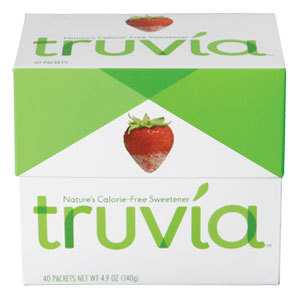Every few years a new sugar alternative hits the market. People who prefer to get their sweeteners’ calorie-free rush to buy up the local supermarket’s stock and eagerly tout the benefits of the latest and greatest sweet invention. About a decade ago sucrolose (aka Splenda) gave Sweet ‘n Low and Equal a run for their money. Agave nectar has received a “health halo” among some people, despite the fact that it is nearly all fructose and may be worse for your health than table sugar or high fructose corn syrup. Most recently, another non-sugar has made a splash in our coffees.
Stevia (sold at health food stores as Truvia, PureVia, Sun Crystals, among others) is made from the sweetest part of the South American stevia plant. The human body cannot use these steviol glycosides as fuel which means the calorie and carbohydrate count is zero. It also tastes 200-300 times sweeter than sugar.
As with any new product, there are some questions that you may want answered. So, I got ya covered:
Is Stevia Safe?
Stevia has been used safely for a long time in South American and Asian countries. Stevia has been the subject of quite a bit of rigorous research assuring the safety of the sweetener, and has been approved by the FDA. Other calorie-free sweeteners such as saccharin (Sweet ‘n Low), aspartame (Equal), and sucralose (Splenda) have also been approved as safe.
Can I Bake with Stevia?
Unlike saccharin or aspartame, which denature (change molecular structure) under high heat, you can bake with Stevia! Check out these Truvia chocolate chip cookies as an example.
Is it Worth Switching My Sweetener?
It depends. While Stevia may be natural, and fits in with the current trend to consume less processed foods, it still should be used in moderation. It can be a great alternative to caloric sweeteners (sugar) as part of a balanced diet if you like the taste.
Here’s how I’d assess the sweetener issue:
- If you are someone who is drinking soda, sweet tea, or other sweetened beverages, start to make the transition to water or lightly sweetened water-based beverages. You may be gulping down gobs of added sugar, which leads to diabetes and weight gain. If you already have diabetes or have been told that you are pre-diabetic, take heed now to cut back on foods and beverages with added sugars.
- Take a look in your pantry… are you addicted to diet foods? Do you have a lot of packaged low-cal stuff that you snack on and no real food to speak of? Maybe there’s a problem. A few artificially sweetened treats may be fine, but if you are loading up on packaged snacks all day, you lose a chance to get good nutrition. Have a fat-free Greek yogurt with fruit instead of a sugar-free pudding.
- Retrain your sweet tooth. If you really feel like you overdo it on all things sweet, maybe your whole eating plan needs a makeover. You’ll find by eating healthy, whole foods that your need for sweets goes down over time.
- As with anything you add to coffee, cereal, or baked goods, taste makes all the difference. Use what tastes good to you – just because Stevia comes from a plant doesn’t mean it’s any better (or worse) for your health. You have to enjoy your food. If you prefer sugar, fine. If you prefer Stevia, fine. If you prefer artificial sweetener, fine too. As long as you don’t think you are overdoing it. If you aren’t sure, you can always have your eating habits evaluated by a dietitian.
